A dog-tired knight on his return journey from the Crusades travels through a country plagued by the plague where he meets, in a literal sense, death himself. Not death warmed over, but death. Unambiguous death in black and white. The only one spared is a visionary strolling player together with his family. He exclaims to his wife: And Death, the severe Master invites them to dance, he tells them to hold each other’s hands and they tread the dance in a long row, a solemn dance towards the dark lands…” In the film, The knight’s talent as a chess player win him some reprieve from fate, and he used this time to save a young family. Or did he?
As with much of Bergman’s films, they are about the self and one’s negotiation with it and without it, the difficulty, using Levinas’ terminology to engage the face, and the seeming inability of Bergman to not permit himself to be touched. Guilt. You could say Bergman’s wavering faith or lack of faith is still a form of faith. From a distance of fifty years, Seventh Seal is a bit tragically morbid, slightly grotesque and even something of a black comedy; the impulsive id beyond desire. Beyond redemption. Another case that may conform to Freud’s view that a work of art is, in large measure, a sublimation of desire, and even a wish fulfillment. But, despite the flaws, it never dips into kitsch or the perverse, but the backdrop of the Plague is almost a metaphor for potential madness, always lurking, almost disquietingly normal within the context of death and the sense of implied sexual obsession and panic.
…The film a ends with one of the most popular fifteenth-century representations of mortality, the Dance of Death, like the Holbein painting, in which Death leads away over the horizon a dancing string of victims from every walk of life, which importantly represents the breaking of the medieval hierarchy, feudalism, serfdom, and the early yawns of democracy, the root, the foundation, of this massive construction of bourgeois values and the new dynamics of domination and subjugation they would engender and which would permeate all his subsequent films.
In addition to Strindberg, Bergman also takes up the Kafka themes, on whether there is salvation in this world or any other, and the Kafka theme of whether it is actually possible to be alive, and equally, that our lives a simply a process to which we must submit to. Perhaps, like many in the wake of WWII, he also questioned convention with a theme of the holy without god, and the silence of god, similar to Camus. A world without god in which the individual carries their own holiness with them.
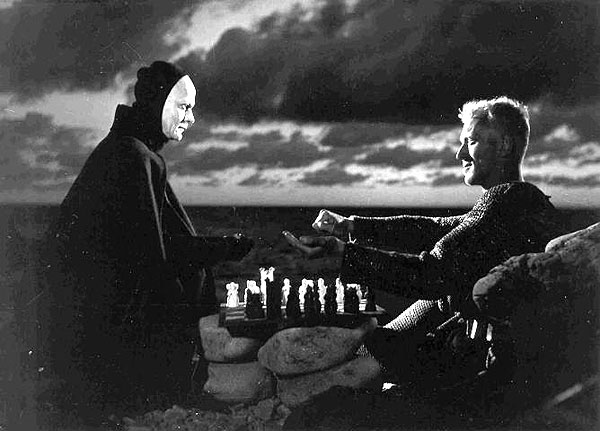
---We wonder what the relationship is between the existence of God and that significant act, and what he means by the latter. There is a possible explanation, although we may be attempting to cover Up what could be a weakness in the philosophical foundation of the film. If the universe is absurd--beginning and ending in purposeless accident that is governed as long as it exists by physical laws of cause and effect--then no deed can be meaningful, if one means by this phrase an action that convinces the doer that there is some purpose in existence. (It is worth noting; that "significant act" is the translation of the Swedish that appears in the subtitles of the film, whereas in the script published by Simon and Schuster, the phrase appears as "meaningful act.") The logic of the Knight might be that if he can perform an act that he considers meaningful, then the universe is not entirely absurd, some power beyond the physical is controlling our lives. This seems rather an equivocal proof of God's existence, depending as it does on individual evaluation. The Knight, however, is desperate and strains to hear even in the slightest sound what he can identify as the authentic voice of God. In any case, as we will see, Antonius does not accept finally his significant deed as the evidence he seeks.--- Read More:http://course1.winona.edu/pjohnson/h140/seal2.htm image:http://shotcontext.blogspot.com/2011/07/chess-game.html
Bergman has always adopted , or posited the position that christ has no body now on earth; a take clearly opposed to the religious epiphany of the emptying of the self, the rapture, the filling, capping and sealing of divine presence, to which he has always associated mental illness with, without looking at the more profound side, the Buber dialog as an option to defuse and circumvent the intensity; intensity something Bergman seemed clearly wary of, as if the self-perceived purity of his own blood- he was an early admirer of Hitler- could be contaminated.
The other element though is craft, and Bergman camerawork was always very subtle, the dark shadows, and his focus on given issues, though obsessive, were thorny and sticky, but he worked them through in a process, on and on, working it through. It was not a cinematic ruse or an act. There is a rare talent at work, one which can hold the traumatic moment in a tension filled dynamic in the collision between empathy and anguish, torment and the strictures of “good behavior.” A willingness to articulate the trauma of existence, even when the scenario is more whimsical. There is Baudelaire gnawing at the edges, with Bergman acting as “the poet as fencer”. The cleverness of Bergman is that the camera becomes in a sense, the spectator of the experience, meaning that the viewer is not encumbered with the notion of voyeurism or passive complicity.
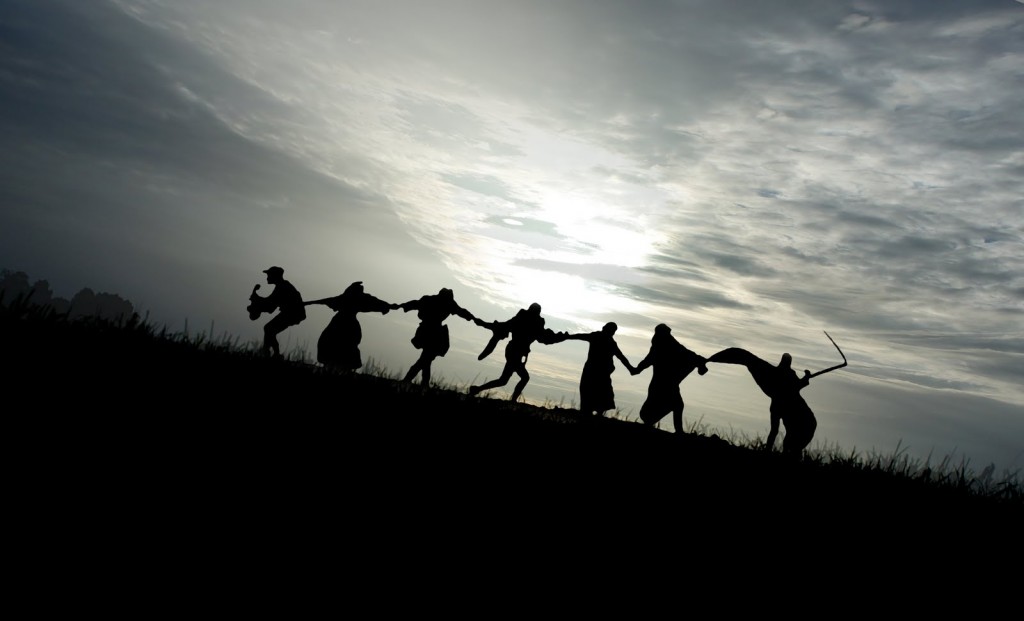
---Although Death remarks that nothing and no one escapes him, Antonius obviously feels that by appearing accidentally to knock over the chessmen, he gives Jof and his family a chance to flee. The Knight has performed his significant act and now should be truly content. Yet he continues to question Death just before the specter leaves. In the castle at Antonius's last moment, he cries to God for mercy. As we point out in our analysis of this penultimate sequence, he is asking God to reveal Himself before it is too late. As far as we know, the silence is not broken. The Knight has failed in his quest and in the end, with the others, he dances to the tune of Death.--- Read More:http://course1.winona.edu/pjohnson/h140/seal2.htm
The main problem concerning Death is whether he is to any degree a free agent or is completely controlled by an omniscient and omnipotent deity that has already planned every move of the game of life. Evidence for the latter view includes Death’s own statement that there are no secrets and he knows nothing, although he is infuriatingly ambiguous in everything he states and we share the Knight’s sense of frustration. We wonder why Jof and his family are allowed to live, for nothing and no one escapes Death. Or were they never threatened? Death has only insinuated that they were in danger. Perhaps they were not destined to die at this time. In that case, Antonius gained nothing for them by his ruse. Perhaps everything that happens to the Knight during his journey was staged (it is possible that the entire film is a dream), so that
nius is allowed, although he does not recognize it, to find salvation by an act of love.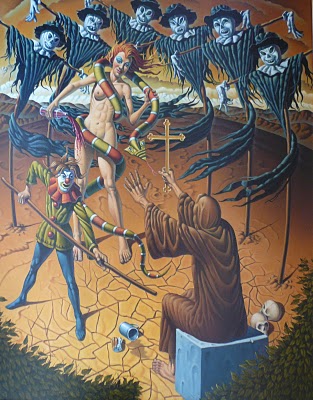
bill sala. The Ttemptation of Saint Anthony. Read More:http://metalonmetalblog.blogspot.com/2010/06/temptations-of-saint-anthony.html
On the other hand, if Death is not a free agent, why does he trick the Knight into revealing his strategy? Or is it possible that Death is a natural force, a manifestation of the rhythms of nature that has no purpose beyond regeneration of itself? As we will point out in “Analysis of Major Sequences,” one of the most repeated visual motifs in the film is the passing of man and his works while nature persists. Read More:http://course1.winona.edu/pjohnson/h140/seal2.htm
ADDENDUM:
“I still held on to some of the withered remains of my childish piety. I had until then held a totally naïve idea of what one would call a preternatural salvation. My present conviction manifested itself during this time. I believe a human being carries his or her own holiness, with lies within the realm of the earth; there are no otherworldly explanations. So in the film lives a remnant of my honest, childist piety lying peacefully alongside a harsh and rational perception of reality.” … Read More:http://www.ingmarbergman.se/universe.asp?guid=481D6999-B979-449F-A789-CF8583560D70&LanCD=EN…
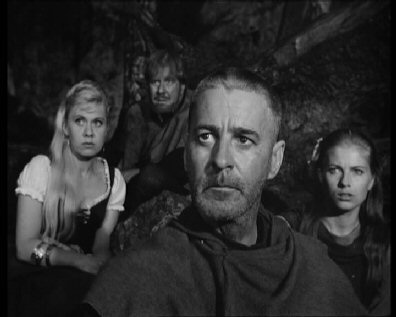
--The chief justification for the view of a number of critics that The Seventh Seal is an existentialist film lies in the character of Jons. The fourteenth-century Squire would have no trouble understanding a philosophy which advocates that existence precedes essence, that the human condition is absurd, that man is free to create his own values, and that the man of good faith must engage in actions for which he accepts responsibility. The Squire's last words in the film might serve as an epigraph for any book on existentialism: "Yes, I accept death, but under protest." It is thus understandable that many viewers identify more easily with Jons than Antonius Block and consider him the true hero of the film. Read More:http://course1.winona.edu/pjohnson/h140/seal2.htm image:http://minnesota.publicradio.org/collections/special/columns/movie_natters/archive/2007/09/watching_the_se.shtml
…The two crusaders have arrived at a church. While Jons talks to a painter who is depicting on the walls of the porch of the church scenes from the plague, the Knight enters the chapel. He confesses to a monk whose face is hidden his religious doubts, his search for manifest evidence of God’s existence, and his desire to perform a significant act before he dies. He also describes the strategy of his chess game with Death. The monk turns out to be his opponent. When Antonius and Jons leave the church, they find soldiers guarding a young girl (Tyan) who is accused of being a witch and is to be burned at the stake.
Knight and Squire next stop at a deserted village for water. Jons meets and threatens a renegade priest (Raval), who is robbing corpses. The Girl whom the Squire saves from being raped by Raval agrees to become his housekeeper….

---...the final image of The Seventh Seal is not of that guy, Death, leading his victims in a dance, but rather of this healthy new family making its way toward a new life. --- Read More:http://glennkenny.premiere.com/blog/2007/07/thirteen-ways-o.html
…The actors are performing before an inn, with the Knight, the Squire, and the Girl in the audience. Skat goes off with Lisa, the wife of the smith (Plog). Jof and Mia’s singing is interrupted by a procession of penitents and a monk’s sermon.
Later Jof is bullied by Raval in the dining room of the inn, but is saved by Jons, who brands the renegade priest. Meanwhile, near the inn the Knight enters into a conversation with Mia. Jof, bruised and frightened. arrives and is solaced by his wife. The three sit down to a repast of strawberries and milk; they are joined by Jons and the girl. Antonius is deeply moved by the peacefulness of the moment and with new confidence continues his game of chess with Death.
Before the Knight and his company, which now includes Jof and the juggler’s family, leave the inn and enter the forest, Plog, who is searching for his errant wife, attaches himself to Jons. In the forest, they meet Skat and Lisa. To escape the burly smith, the actor pretends to commit suicide. but after the others have left, he is actually taken away by Death. The specter appears again as the group witnesses the burning of Tyan. While they are in the forest, Raval comes to them infected with the plague and dies in agony.
Soon after the death of Raval, the Knight loses his game with Death; however, he is able to divert the specter while Jof, Mia, and their child escape. During a storm that arises, the juggler and his family hide in their wagon.
The Knight and the remainder of the group (Jons, the Girl, Plog, and Lisa) reach his castle and find Antonius’s wife (Karin) awaiting him. During dinner Death appears.
…In the epilogue, Jof and Mia emerge from the wagon at the edge of a shore. Jof has a vision of his friends dancing in a line led by Death. He and his family move along the shore in the light of a clear dawn. Read More:http://course1.winona.edu/pjohnson/h140/seal2.htm


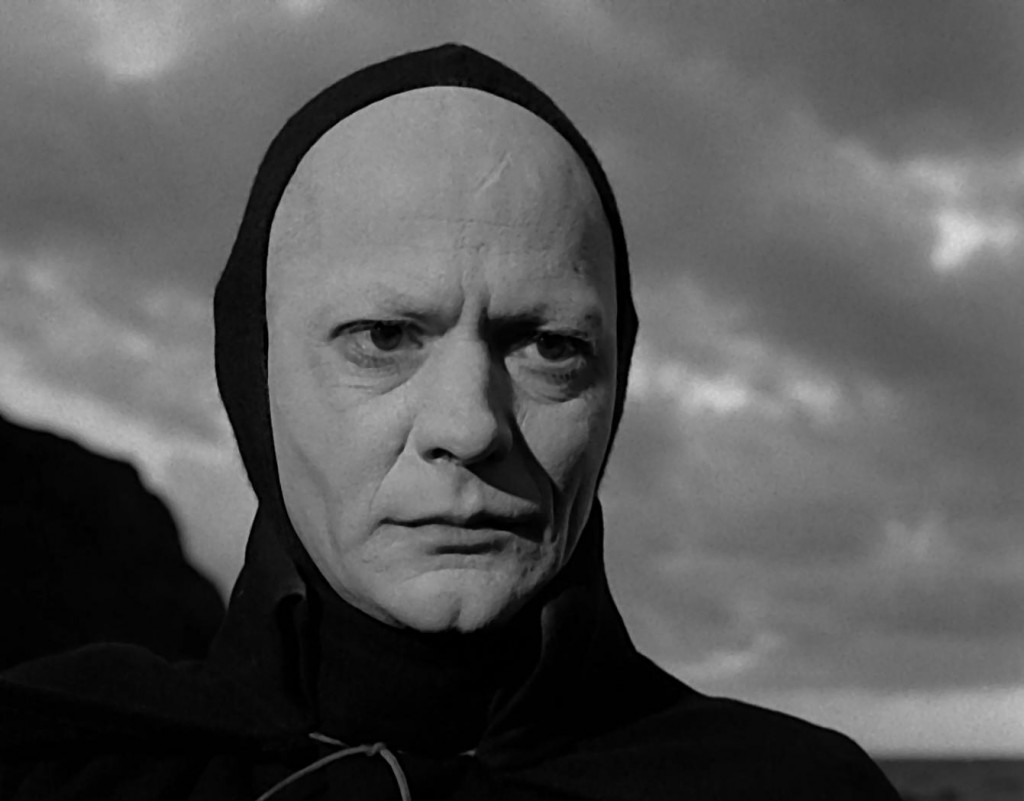




 COMMENTS
COMMENTS